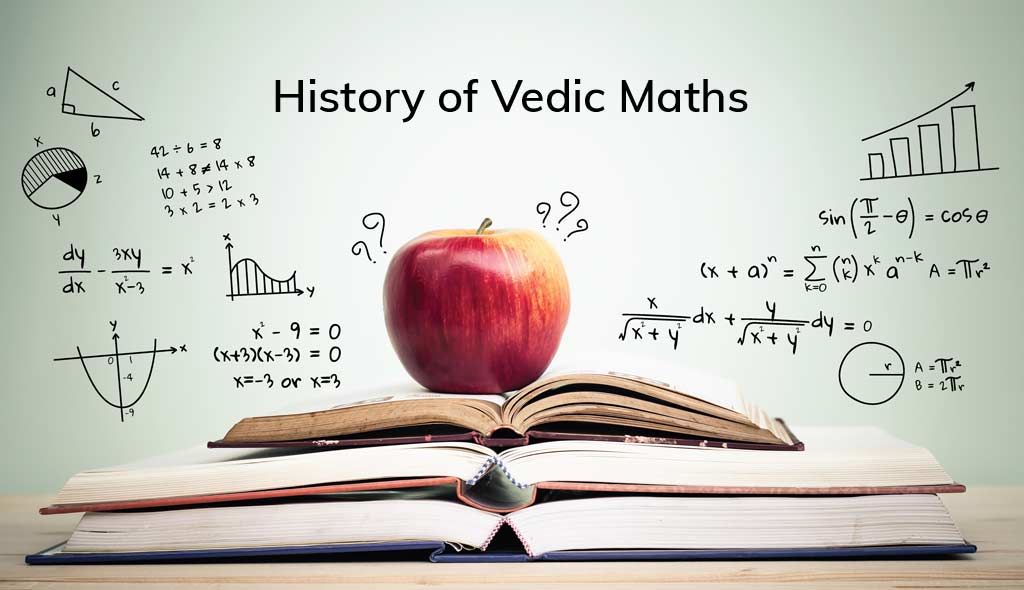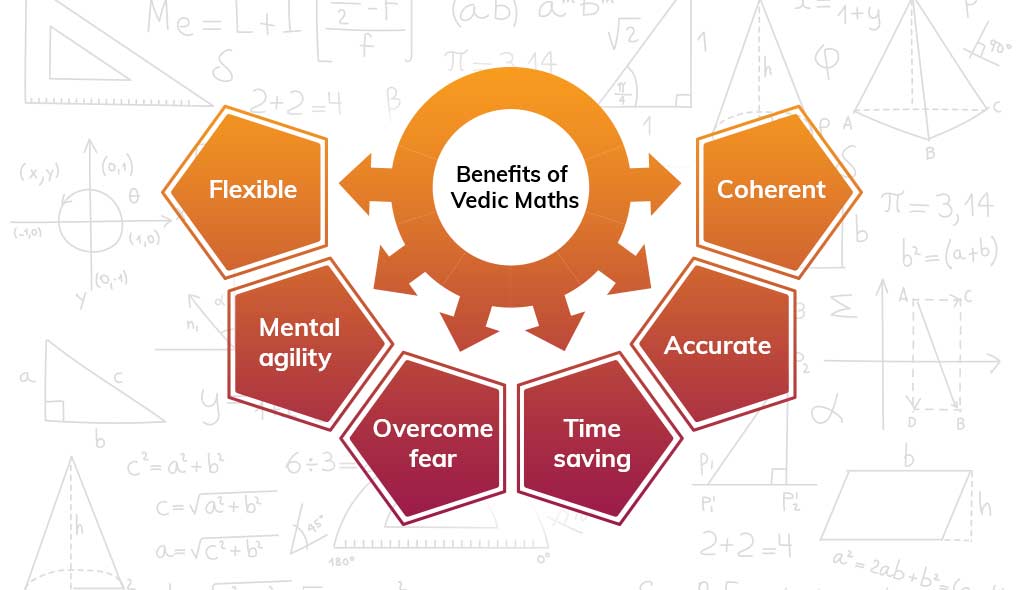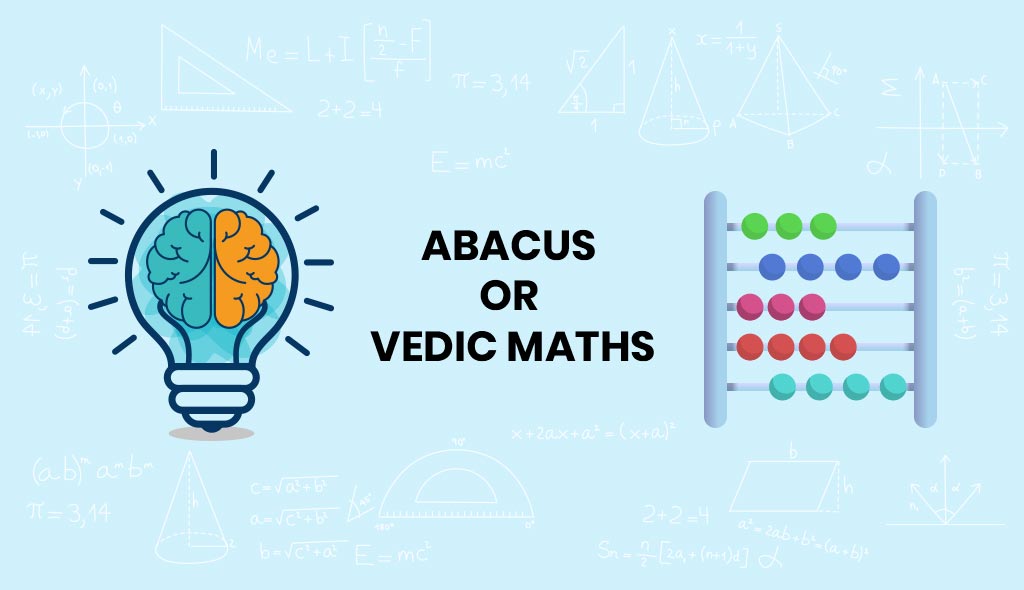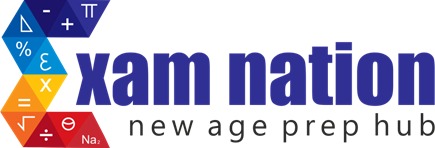Vedic Maths

An All-Inclusive Guide to Vedic Maths
How long will you take multiplying 962×456 mentally? Or say, process the calculation of 1/26? Traditional calculations should take roughly 5 minutes or so with several intermediate steps for each of the above calculations. But what if we tell you that there’s a quicker method of calculating these? It’s possible to work out these arithmetical calculations in a matter of seconds. And the techniques to do so are what comprise Vedic Maths.
Vedic Mathematics is a collection of Sutras or techniques that you can use to solve problems involved in arithmetic, algebra, geometry, and other fields of mathematics. It teaches us to use these techniques for computing virtually any type of numerical calculations mentally, in a matter of seconds.
Calculations, which otherwise take numerous steps to solve, can be solved with just a few steps, and sometimes with no intermediate steps at all, in Vedic mathematics.
So, what exactly is Vedic Maths? Chances are that you have already heard the term and willing to know the details. If that’s the case, then read on. Or even if you haven’t heard of it, read on as well. Because Vedic Maths is something that makes Mathematics a lot of fun.
What is Vedic Maths?
As mentioned, Vedic Maths is a collection of 16 sutras (formulae) and 13 sub-sutras (sub-formulae) that can be used for super-fast calculations. These calculations, mostly numeric, can be applied for solving various problems in algebra, arithmetic, geometry, trigonometry, calculus, and conics.
Right from multiplication to division to finding square and cube roots to solving linear equations, Vedic Maths finds its use everywhere in Mathematics. It’s simple, fast, effective, and is free from the tedious calculations that are involved in the traditional system of mathematics.
The learning of these sutras is so simple that even someone with a basic understanding of Mathematics can easily adopt them. The sutras are complete by themselves and applicable to virtually every type of mathematical calculations.
Why is it called Vedic Maths?
The term ‘Vedic Maths’ was coined by Shri Bharati Krishna Tirthaji, an Indian monk. He claimed that he discovered these sutras in the Vedas while deeply studying them. According to Shri Bharati Krishna Tirtha, he spent years of solitary study of the Vedas in a forest and discovered the sutras in the supplementary text of the Atharvaveda.
He then went on to study these sutras and eventually published them in the form of a book titled ‘Vedic Mathematics’ in 1965. Vedic Maths, as we know today, comes directly from Shri Bharati Krishna’s work and has been known by this name. The name itself is quite apt seeing that it is a part of the Vedas and supposedly contains all mathematical computational wisdom.
What is the History of Vedic Maths?

Vedic Mathematics first came into light in 1965 when Shri Bharati Krishna Tirtha published the Sutras and explained them in detail in a book by the same title. He wrote the book in 1957 and it was published only five years after his death. He claimed that he found the sutras in the parisistha or appendix of Atharva Veda while deeply learning the Vedas for years in a forest.
However, no standard version of the Atharva Veda has these sutras and that has been a major source of questions from renowned mathematicians all over the world. They claim that these sutras were a product of BharatiTirtha’s own academic training and of the deep learning that he had about mathematics.
However, Bharati Krishna said that it’s true that the standard editions of Atharvaveda do not contain these sutras and he came across them in an undiscovered version of the text that he came across by chance.
Whatever be the truth, the fact remains that Vedic Maths comprises of extremely simple forms of computational methods and can be used for calculating faster. The work of Bharati Tirtha, though, has faced numerous questions and challenges remain one of the finest collection of computational techniques and have been praised by the same people who questioned its authenticity.
Some governments have even attempted to integrate Vedic Maths in the regular curriculum of schools seeing that it yielded faster results.
So, we can safely say that whether or not the sutras are from the Vedas, the techniques work perfectly well and can help in super-fast calculations in elementary, middle, and high-school mathematics and algebra. Whether the student is in CBSE, ICSE, IGCSE, ISC, IB, or any other board, these mathematical techniques are equally applicable to everybody.
What is the Use of Vedic Maths?
Vedic Maths can be used for faster calculations. We can find its use in not only arithmetic but also in algebra, geometry, trigonometry, and calculus. It consists of simple rules for computation involving numbers and can be used to do multiplications, divisions, finding square roots, cube roots, complex numbers, squaring, cubing. You can even solve recurring decimals and auxiliary fractions in the fastest manner using the principles of Vedic Mathematics.
It is to be remembered, however, that Vedic Maths is not a separate numeral system. It is a set of rules which when applied can help calculate faster. It provides a set of simple, and easy-to-understand alternates to calculate the otherwise complicated and cumbersome calculations.
Vedic Maths can be used to calculate 5-15 times faster using simple techniques. And thus can be extremely helpful where quick mental calculations are needed. It can be used as a supplementary method of calculation in schools, colleges, and especially in competitive exams, where the use of calculators is restricted.
What are the Benefits of Learning Vedic Maths?

Today’s world is a highly competitive one and Maths, as is seen, is generally a scary subject to school students. The traditional system of computations requires rigorous, often cumbersome calculations to arrive at the answer. Mathematical methods like calculating fractions, roots, are complex, partly why school students start hating Mathematics as a subject when they fail to understand and apply the techniques taught to them.
Vedic Maths can come to the rescue here, because not only the calculations are simple to understand, but also yield extremely fast results. Vedic Maths is thus suited for everyone eager to learn a supplementary method of calculation that does not involve rigorous pen and paperwork to arrive at the answers.
The benefits of Vedic Maths however are far beyond that. It not only helps a student to calculate faster but also develops his/her mental faculty of imagination and mental calculation. Also, students get relieved of their fear of Mathematics when they can successfully calculate and arrive at the correct answer.
Benefits of Vedic Maths:
- It requires you to learn the mathematical table of up to 9, thus you are freed of the burden of remembering a large amount of stuff.
- You can save a lot of time, which otherwise you would have needed to spend on calculations, and thus you can utilize that time in answering more questions in an exam.
- It reduces scratch work and finger counting to a great extent.
- It encourages mental calculations and visualizing and thus helps in developing mental faculties like concentration and confidence.
- Vedic Maths helps enrich our understanding of Mathematics and thus we can see a continual link between different branches of it.
What is the Right Age to Learn Vedic Maths?
Vedic Maths is an alternative method of basic mathematical operations. It can act a supplementary to the standard and established way of making calculations. So, once the traditional method is learned, Vedic Maths can then be used as an alternate way of making those calculations.
So, for adults, any age is the right age. But for kids, the examination system evaluates how well they have learned the basic standard techniques of calculations. How well they can perform the traditional techniques of multiplication, finding factors, division, etc.
So, they need to learn those techniques first. After learning and understanding those techniques and how they work, they can then learn Vedic Mathematics. They are then slightly grown and the examination evaluations are not dependent on the performance of the standard techniques. So, they can then easily learn and adopt them. Vedic Maths can be an effective tool for improving grades without studying for long hours.
What are the 16 Sutras of Vedic Maths?
As already mentioned, Vedic Maths is a collection of 16 sutras or techniques presented in the form of aphorisms. These 16 sutras can be used for any mathematical operation ranging from multiplication, division, solving linear equations, and many more. Now let’s learn what these 16 sutras are and where they are used.
1. EKADHIKENA PURVENA (by one more than the previous)
This sutra is very useful in finding the product of numbers if the sum of the unit digit of the two numbers in question totals to 10.
2. NIKHILAM NAVATASHCARAMAM DASHATAH (all from 9 and last from 10)
This sutra is mostly used in subtracting a number from the powers of 10.
3. URDHVA-TIRYAGBHYAM (vertically and crosswise)
This sutra again is used for multiplications and the formula is of the form:
ab x cd = (a.c) (a.d + b.c) (b.d) where ‘.’ refers to multiplication.
4. PARAAVARTYA YOJAYET (transpose and adjust)
This sutra is used for solving division problems when the divisor is a little greater than the nearest power of 10. So, this sutra can be applied to divisions like 456/12.
5. SHUNYAM SAAMYASAMUCCAYE (when the sum is the same, that sum is zero)
This sutra is used to solve linear equations of the forms:
- ax + bx + cx + dx + 0
- a (x+b) = c (x+b)
6. ANURUPYE SHUNYAMANYAT (if one is in ratio the other is equal to zero)
This again is used to solve equations of a special type.
7. SANKALANA VYAVAKALANABHYAM (by addition and subtraction)
This sutra too is used to solve linear equations. This simply states that when there are two equations of two variables and the coefficient of 1st variable in equation 1 is equal to the coefficient of 2nd variable in equation 2, and vice versa, then those two equations can be added and subtracted to solve for the variables.
8. PURANAPURANABHYAM (by the completion or non-completion)
This sutra can be used for solving addition problems where the unit digits of the numbers add up to 10.
9. CHALANA KALANABHYAM (difference and similarities)
This sutra finds its application in calculus to find the roots of a quadratic equation. It can also be applied in differential calculus for factorizing 3rd, 4th, and 5th degree expressions. So, this sutra is meant for application in higher mathematics.
10. YAAVADUNAM (whatever the extent of its deficiency)
This sutra is used to find squares of numbers when the number is close to the powers of 10.
11. VYASHTISAMANSTIH (part and whole)
This sutra is used in the factorization of quadratic equations.
12. SHESANYANKENA CHARAMENA (the remainders by the last digit)
This sutra can be used for converting fractions to decimals.
13. SOPAANTYADVAYAMANTYAM (the ultimate and twice the penultimate)
This sutra is used to find the solution of equations of the form:
1/ab + 1/ac + 1/ad + 1/bc, where a, b, c, and d are in arithmetic progression.
14. EKANYUNENA PURVENA (by one less than the previous)
This sutra can be used to perform multiplications when the multiplier consists of only 9.
15. GUNITASAMUCHYAH (the product of the sum is equal to the sum of the product)
This sutra is used to find the correctness of the answers in factorization problems. It states that if the sum of the coefficients in the product is equal to the sum of the coefficients of the factors, then an equation can be said to be balanced.
16. GUNAKASAMUCHYAH (the factor of the sum is equal to the sum of the factors)
This sutra tells that if the sum of the factors is equal to the factor of the sums of a number, then that number is perfect.
These are the complete 16 sutras of Vedic Maths and the most common scenarios where they are applied. As seen, by the use of these principles, we can perform almost every type of mathematical operation easily and in a much faster manner.
Which is Better- Abacus or Vedic Maths?

Abacus and Vedic Maths both are ancient mathematical calculation techniques brought into today’s use. They both serve the purpose of calculating in a faster manner. Now let’s try to learn what Abacus is before comparing it with Vedic Maths.
Abacus
Abacus Math uses a mechanical device to help calculate fast. The device comprises of beads that can be moved up and down along several columns. The columns and the placement of beads in the Abacus signifies different numbers. And based on certain rules, those beads can be moved up and down performing different mathematical operations in the process.
The exact period and origin of Abacus is unknown. Ancient Greek, Mesopotamian, Egyptian, and Roman are noted to use similar tools to help them with their calculations. However, it was in China that Abacus was modified as an instrument to calculate and put into daily use.
Abacus is often used in pre-schools and elementary schools as an aid in helping children grasp the ideas of numerical system and arithmetic. It helps them with their understanding and calculations.
However, Abacus can perform only four basic arithmetical operations, viz. addition, subtraction, multiplication, and division. In comparison, Vedic Maths comprises of techniques that can be applied in higher arithmetic as well. But that is not the only difference.
Comparison between Abacus and Vedic Maths
Vedic Maths and Abacus both are used for fast calculations. However, the practice and use of these two tools or techniques of calculation are suitable for different age groups of people and serve different purposes. Abacus is primarily used as a brain development program for children between 5 to 14 years. It helps children in this age group to grasp the mathematical techniques faster and also help in their brain development and improvement of learning power.
When children use both their hands to move the beads up and down, it stimulates both the halves of the brain and thus helps in brain development in the early years. Also, Abacus can be used to perform just the basic four arithmetical functions. So, Abacus is suited mainly for children.
In comparison, Vedic Maths is much more comprehensive and can be used to perform a wide range of functions including squares, cubes, and auxiliary fractions. So, it is most suited to a more developed mind when the traditional ways of arithmetic have already been learned. Adults and children from 12 years of age can learn Vedic Mathematics to broaden their knowledge and calculate faster.
So, we see that Abacus is suited to minor children while Vedic Maths is suited to adults and little grownups. They are also different in their operations and serves different purposes. Vedic Maths provides techniques to perform a wide range of mathematical computations while Abacus is mostly used as a brain development program.
How to Learn Vedic Maths?
Choosing to learn Vedic Maths can be a wise choice. It helps develops mental faculties like concentration, visualization, and is a unique way of working with numbers. With Vedic Maths, you get to learn a completely different system and approach to solving different types of numerical and algebraic problems, much faster.
Particularly for middle and high-school school children, Vedic Maths is a great way to make math learning a lot of fun.
For learning Vedic Maths, you first need to go through the sutras and learn to apply them. There are several authentic sources of Vedic Mathematics available freely on the internet. You can use them to learn the tricks and techniques that Vedic Maths comprises of. However, to master the techniques, you need to practice them. For that, follow this simple approach.
Learn a sutra and go through the example that would be provided in the material that you are following. For example, say you are learning multiplication. So, first, learn the Vedic Math technique by going through the examples and then take up any random multiplication and then try to solve it using the sutras.
Approximately, practicing the application of the sutras for about 1 one hour a day for 8 or more months will help master the techniques. And then, you can apply them as and when needed.
Conclusion
Vedic Maths is an ancient system of doing mathematical calculations and is a much faster way of doing them. Problems that otherwise take rigorous calculations and paperwork can be solved just mentally using the techniques of Vedic Maths.
It’s a great tool for doing arithmetic and algebraic calculations and can be an alternate way of doing them. So, you will make a wise choice if you learn it. Just make sure to practice the applications daily to master the techniques. Happy learning!

